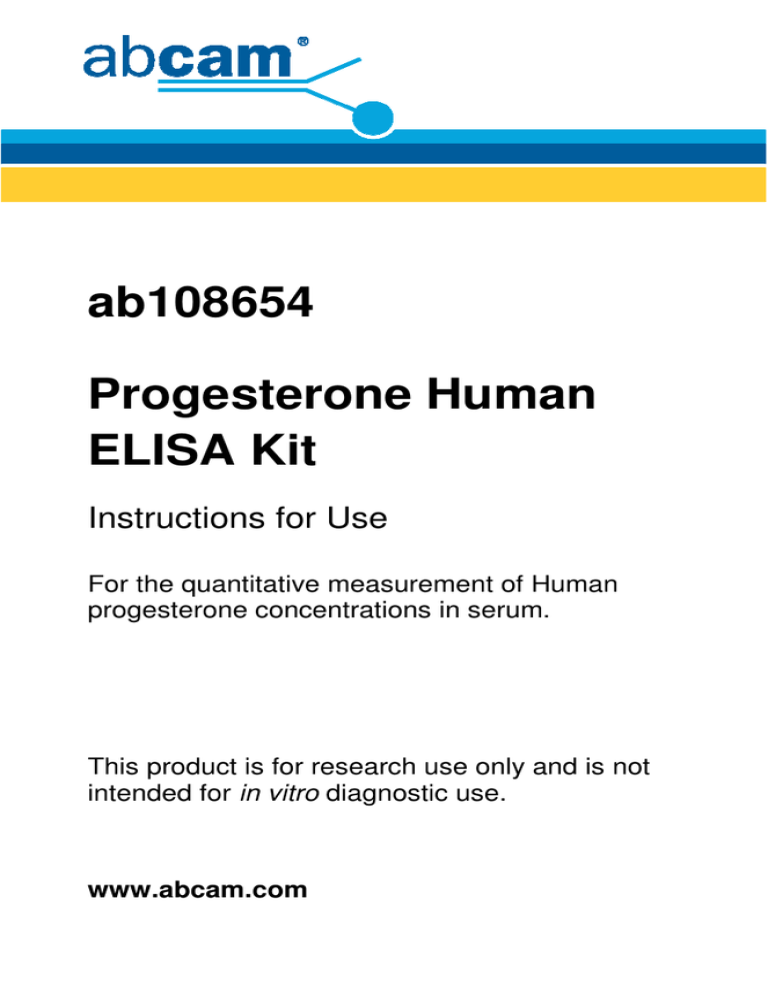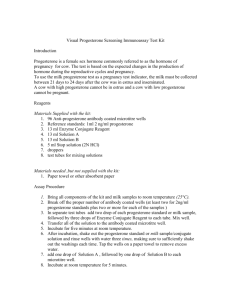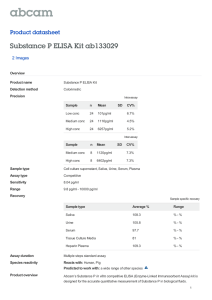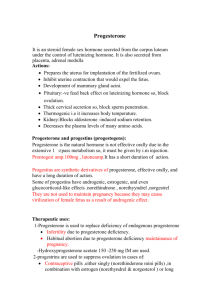
ab108654
Progesterone Human
ELISA Kit
Instructions for Use
For the quantitative measurement of Human
progesterone concentrations in serum.
This product is for research use only and is not
intended for in vitro diagnostic use.
www.abcam.com
ab108654 Progesterone Human ELISA Kit
1
ab108654 Progesterone Human ELISA Kit
Table of Contents
1.
Introduction
3
2.
Assay Summary
4
3.
Kit Contents
5
4.
Storage and Handling
5
5.
Additional Materials Required
6
6.
Preparation of Reagents
6
7.
Preparation and Collection of Specimen
7
8.
Assay Method
7
9.
Data Analysis
8
10. Limitations
16
11. Specificity
17
12. Troubleshooting
19
2
ab108654 Progesterone Human ELISA Kit
1. Introduction
ab108654 is
intended for
the quantitative determination of
progesterone concentration in Human serum.
Progesterone is a C21 steroid which is synthesized from both tissue
and
circulating
pregnenolone
cholesterol.
which
is
Cholesterol
then
converted
is
transformed
via
a
to
combined
dehydrogenase and isomerase to progesterone. The principle
production sites are the adrenals and ovaries and the placenta
during pregnancy. The majority of this steroid is metabolized in the
liver to pregnanediol and conjugated as a glucuronide prior to
excretion by the kidneys.
3
ab108654 Progesterone Human ELISA Kit
2. Assay Summary
ab108654 is based on the principle of competitive binding between
progesterone in the test specimen and progesterone-HRP conjugate
for a constant amount of rabbit anti- progesterone.
In the incubation, goat anti-rabbit IgG-coated wells are incubated
with 25 µl progesterone standards, controls, samples, 100 µl
progesterone-HRP Conjugate Reagent and 50 µl rabbit antiprogesterone reagent at room temperature (18-25°C) for 90 minutes.
During the incubation, a fixed amount of HRP-labeled progesterone
competes with the endogenous progesterone in the standard,
sample, or quality control serum for a fixed number of binding sites
of the specific progesterone antibody. Thus, the amount of
progesterone peroxidase conjugate immunologically bound to the
well progressively decreases as the concentration of progesterone in
the specimen increases. Unbound progesterone peroxidase
conjugate is then removed and the wells washed.
Next, a solution of TMB Reagent is then added and incubated at
room temperature for 20 minutes, resulting in the development of
blue color.
The color development is stopped with the addition of Stop Solution,
and the absorbance is measured spectrophotometrically at 450 nm.
The intensity of the color formed is proportional to the amount of
enzyme present and is inversely related to the amount of unlabeled
progesterone in the sample.
4
ab108654 Progesterone Human ELISA Kit
3. Kit Contents
•
Goat Anti-Rabbit IgG-coated microtiter wells, 96 wells.
•
Progesterone Reference Standards: 0, 0.5, 3.0, 10, 25, and
50 ng/ml. Liquids, 0.5 ml each, ready to use.
•
Rabbit Anti-Progesterone Reagent (pink color), 7 ml.
•
Progesterone-HRP Conjugate Concentrate (11x), 1.3 ml.
•
Progesterone-HRP Conjugate Diluent, 13 ml.
•
Progesterone Control 1, Liquid, 0.5 ml, Ready to use.
•
Progesterone Control 2, Liquid, 0.5 ml, Ready to use.
•
TMB Reagent (One-Step), 11 ml.
•
Stop Solution (1N HCl), 11 ml.
4. Storage and Handling
Unopened test kits should be stored at 2 - 8°C upon receipt and the
microtiter plate should be kept in a sealed bag with desiccants to
minimize exposure to damp air. Opened test kits will remain stable
until the expiration date shown, provided it is stored as described
above.
5
ab108654 Progesterone Human ELISA Kit
5. Additional Materials Required
•
Precision pipettes: 25 µl, 50 µl, 100 µl, 200 µl, and 1.0 ml.
•
Disposable pipette tips.
•
Distilled or deionized water.
•
Vortex mixer or equivalent.
•
Absorbent paper or paper towel.
•
Linear-linear graph paper.
•
Microtiter plate reader with a bandwidth of 10 nm or less and an
optical density range of 0 - 3 O.D. at 450 nm wavelength.
6. Preparation of Reagents
1.
All reagents should be brought to room temperature (18 - 25°C)
before use.
2.
To prepare Working Progesterone-HRP Conjugate Reagent,
add 0.1 ml of Progesterone-HRP Conjugate Concentrate
(11x) to 1.0 ml of Progesterone-HRP Conjugate Diluent
(1:10 dilution) and mix well. The amount of conjugate
diluted depends on your assay size. Discard the excess
after use.
3.
Samples with expected progesterone concentrations over 50
ng/ml may be quantitated by dilution with diluent available from
vendor.
6
ab108654 Progesterone Human ELISA Kit
7. Preparation and Collection of Specimen
1. Only human serum should be used.
2. No special pretreatment of sample is necessary.
3. Serum samples may be stored at 2 - 8°C for up to 24 hours, and
should be frozen at 10°C or lower for longer periods. Do not use
grossly hemolyzed or grossly lipemic specimens.
4. Please note: Samples containing sodium azide should not be
used in the assay.
8. Assay Method
Assay Procedure:
1. Secure the desired number of coated wells in the holder.
2. Dispense 25 µl of standards, specimens, and controls into
appropriate wells.
3. Dispense 100 µl of Working Progesterone-HRP Conjugate
Reagent into each well.
4. Dispense 50 µl of rabbit anti-progesterone reagent to each well
5. Thoroughly mix for 30 seconds. It is very important to mix
completely.
6. Incubate at room temperature (18 - 25°C) for 90 minutes.
7. Rinse and flick the microtiter wells 5 times with distilled or
deionized water. (Please do not use tap water.)
7
ab108654 Progesterone Human ELISA Kit
8. Dispense 100 µl of TMB Reagent into each well. Gently mix for
10 seconds.
9. Incubate at room temperature (18 - 25°C) for 20 minutes.
10. Stop the reaction by adding 100 µl of Stop Solution to each well.
11. Gently mix for 30 seconds. It is important to make sure that all
the blue color changes to yellow color completely.
12. Read absorbance at 450nm with a microtiter plate reader within
15 minutes.
Quality Control:
Good laboratory practice requires that controls are run with each
calibration curve. A statistically significant number of controls should
be assayed to establish mean values and acceptable ranges to
assure proper performance. ab108654 provides internal controls,
Level 1 and 2.
9. Data Analysis
1. Calculate the mean absorbance value (A450) for each set of
reference standards, controls and samples.
2. Construct a standard curve by plotting the mean absorbance
obtained for each reference standard against its concentration in
8
ab108654 Progesterone Human ELISA Kit
ng/ml on a linear-linear graph paper, with absorbance values
on the vertical or Y axis, and concentrations on the horizontal or
X axis.
3. Use the mean absorbance values for each specimen to
determine the corresponding concentration of Progesterone in
ng/ml from the standard curve.
4. Any values obtained for diluted samples must be further
converted by applying the appropriate dilution factor in the
calculations.
A.
Typical Data
Results of a typical standard run with optical density readings at 450
nm shown in the Y axis against Progesterone concentrations shown
in the X axis.
NOTE: This standard curve is for the purpose of illustration only, and
should not be used to calculate unknowns. Each laboratory must
provide its own data and standard curve in each experiment.
9
ab108654 Progesterone Human ELISA Kit
Progesterone (ng/ml)
Absorbance (450 nm)
0
2.719
0.5
1.937
3
1.391
10
0.828
25
0.528
50
0.291
10
ab108654 Progesterone Human ELISA Kit
B.
Sensitivity
The minimum detectable concentration of Progesterone using
ab108654, as measured by 2 SD from the mean of a zero standard,
is estimated to be 0.0625 ng/ml.
C.
Recovery
Various serum samples of known Progesterone levels were
combined and assayed in duplicate. The mean recovery was
111.3%.
EXPECTED
[Progesterone]
OBSERVED
[Progesterone]
(ng/ml)
(ng/ml)
1
41.5
43.1
103.9
2
43.1
45.7
106.1
3
19.9
19.8
99.1
4
18.0
19.2
106.4
5
3.8
4.3
115.4
6
7.3
8.7
118.6
7
0.8
0.7
80.4
PAIR NO.
%
RECOVERY
11
ab108654 Progesterone Human ELISA Kit
D. Reproducibility
Intra-Assay: Within-run precision was determined by replicate
determinations of four different serum samples in one assay. Withinassay variability is shown below:
Serum Sample
1
2
3
4
# Reps.
24
24
24
24
Mean Progesterone
1.8
8.0
21.7
44.8
S.D.
0.1
0.2
0.7
1.1
C.V. (%)
7.1
2.6
3.3
2.4
(ng/ml)
Inter-Assay: Between-run precision was determined by replicate
measurements of four different serum samples over a series of
individually calibrated assays. Between-assay variability is shown
below:
12
ab108654 Progesterone Human ELISA Kit
Serum Sample
1
2
3
4
# Reps.
20
20
20
20
Mean Progesterone
1.7
7.9
21.0
44.6
S.D.
0.2
0.4
1.2
1.1
C.V. (%)
12.6
4.5
5.9
2.6
(ng/ml)
E. Linearity
Four patient samples were serially diluted to determine linearity. The
mean linearity was 105.9%.
13
ab108654 Progesterone Human ELISA Kit
#
Dilution
Observed
Conc. (ng/ml)
44.4
% Expected
Undiluted
Expected
Conc. (ng/ml)
----
1
1:2
22.2
24.9
112.0
1:4
11.1
12.8
115.3
1:8
5.6
7.1
127.7
1:16
2.8
3.5
125.2
1:32
1.4
1.8
126.7
1:64
0.7
0.8
108.5
1:128
0.3
0.3
81.0
----
Mean = 113.8%
2
Undiluted
----
40.6
----
1:2
20.3
22.6
111.2
1:4
10.2
9.8
96.9
1:8
5.1
6.0
118.9
1:16
2.5
2.6
102.0
1:32
1.3
1.2
96.4
1:64
0.6
0.4
70.4
1:128
0.3
0.3
89.1
14
ab108654 Progesterone Human ELISA Kit
Mean = 97.9%
3
Undiluted
----
30.5
----
1:2
15.2
16.6
108.6
1:4
7.6
8.3
108.3
1:8
3.8
4.5
117.9
1:16
1.9
2.1
112.1
1:32
1.0
0.5
54.4
1:64
0.5
0.3
69.5
Mean = 95.1%
4
Undiluted
----
41.9
----
1:2
20.9
24.7
118.1
1:4
10.5
12.1
115.3
1:8
5.2
7.1
135.6
1:16
2.6
3.7
142.1
1:32
1.3
1.8
135.8
1:64
0.7
0.5
72.7
1:128
0.3
0.3
99.0
Mean = 116.9%
15
ab108654 Progesterone Human ELISA Kit
F. Expected Values
Each laboratory should establish its own normal range based on the
patient population. The Progesterone Human ELISA Kit was
performed on randomly selected outpatient clinical laboratory
samples.
Males:
adult
0.13 0.97 ng/ml
Prepubertal (children)
0.07 0.52 ng/ml
Females: follicular phase
0.15 – 0.70 ng/ml
luteal phase
2.00 – 25.0 ng/ml
post menopausal
0.06 – 1.60 ng/ml
Pregnancy:
1st trimester
10.3 – 44.0 ng/ml
2nd trimester
19.5 – 82.5 ng/ml
3rd trimester
65.0 – 229 ng/ml
10. Limitations
•
Reliable and reproducible results will be obtained when the
assay procedure is carried out with a complete understanding of
the package insert instructions and with adherence to good
laboratory practice.
•
Serum samples demonstrating gross lipemia, gross hemolysis,
or turbidity should not be used with this test.
16
ab108654 Progesterone Human ELISA Kit
•
The wash procedure is critical. Insufficient washing will result in
poor precision and falsely elevated absorbance readings.
•
The results obtained from the use of this kit should be used only
as an adjunct to other diagnostic procedures and information
available to the physician.
11. Specificity
The following materials have been checked for cross reactivity. The
percentage indicates cross reactivity at 50% displacement compared
to Progesterone.
Data
on
the
cross-reactivity
for
several
endogenous
and
pharmaceutical steroids are summarized in the following table:
Cross reactivity (%) = Observed Progesterone Concentration x 100
Steroid Concentration
17
ab108654 Progesterone Human ELISA Kit
Steroid
Cross-Reactivity
Progesterone
100%
Androsterone
0.086%
Corticosterone
0.74%
Cortisone
0.11%
Cholesterol
< 0.08%
Estradiol
< 0.01%
Estrone
0.08%
Estriol
< 0.024%
Prednisolone
0.075%
Testosterone
0.1%
18
ab108654 Progesterone Human ELISA Kit
12.
Troubleshooting
Problem
Cause
Solution
Poor standard
curve
Improper standard dilution
Confirm dilutions made
correctly
Standard improperly
reconstituted (if
applicable)
Briefly spin vial before
opening; thoroughly
resuspend powder (if
applicable)
Standard degraded
Store sample as
recommended
Curve doesn't fit scale
Try plotting using different
scale
Incubation time too short
Try overnight incubation at
4 °C
Target present below
detection limits of assay
Decrease dilution factor;
concentrate samples
Precipitate can form in
wells upon substrate
addition when
concentration of target is
too high
Increase dilution factor of
sample
Using incompatible
sample type (e.g. serum
vs. cell extract)
Detection may be reduced
or absent in untested
sample types
Sample prepared
incorrectly
Ensure proper sample
preparation/dilution
Bubbles in wells
Ensure no bubbles
present prior to reading
plate
Low signal
Large CV
19
ab108654 Progesterone Human ELISA Kit
High
background
Low sensitivity
All wells not washed
equally/thoroughly
Check that all ports of
plate washer are
unobstructed/wash wells
as recommended
Incomplete reagent mixing
Ensure all
reagents/master mixes
are mixed thoroughly
Inconsistent pipetting
Use calibrated pipettes
and ensure accurate
pipetting
Inconsistent sample
preparation or storage
Ensure consistent sample
preparation and optimal
sample storage conditions
(eg. minimize
freeze/thaws cycles)
Wells are insufficiently
washed
Wash wells as per
protocol recommendations
Contaminated wash buffer
Make fresh wash buffer
Waiting too long to read
plate after adding STOP
solution
Read plate immediately
after adding STOP
solution
Improper storage of
ELISA kit
Store all reagents as
recommended. Please
note all reagents may not
have identical storage
requirements.
Using incompatible
sample type (e.g. Serum
vs. cell extract)
Detection may be reduced
or absent in untested
sample types
For further technical questions please do not hesitate to
contact us by email (technical@abcam.com) or phone (select
“contact us” on www.abcam.com for the phone number for
your region).
20
ab108654 Progesterone Human ELISA Kit
21
ab108654 Progesterone Human ELISA Kit
22
ab108654 Progesterone Human ELISA Kit
Abcam in the USA
Abcam Inc
1 Kendall Square, Ste B2304
Cambridge,
MA 02139-1517
USA
Toll free: 888-77-ABCAM (22226)
Fax: 866-739-9884
Abcam in Europe
Abcam plc
330 Cambridge Science Park
Cambridge
CB4 0FL
UK
Tel: +44 (0)1223 696000
Fax: +44 (0)1223 771600
Abcam in Japan
Abcam KK
1-16-8 Nihonbashi
Kakigaracho,
Chuo-ku, Tokyo
103-0014
Japan
Tel: +81-(0)3-6231-094
Fax: +81-(0)3-6231-0941
Abcam in Hong Kong
Abcam (Hong Kong) Ltd
Unit 225A & 225B, 2/F
Core Building 2
1 Science Park West Avenue
Hong Kong Science Park
Hong Kong
Tel: (852) 2603-682
Fax: (852) 3016-1888
23
Copyright © 2011 Abcam, All Rights Reserved. The Abcam logo is a registered trademark.
All information / detail is correct at time of going to print.






